- info@wildlifeanimalcontrol.com
Call us for help in your town
Wildlife Control Education
Dead Animal Removal Tips
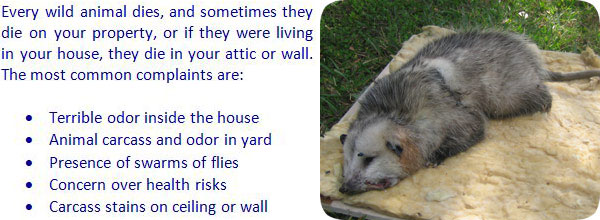
Summary of Step-By-Step Instructions:
1) Attempt to narrow down the odor to one specific room - this can actually be tricky, because the odor will be strongest in an area with the least air flow, even if it's not closest to the dead carcass.
2) If you have an elevated house, crawl underneath to look for a dead opossum, raccoon, or stray cat.
3) Crawl in the attic above the worst-smelling room, and move back and forth, sniffing all the way. You may have to dig around in the insulation, in case a rat has died in there.
4) If the animal is in a wall, sniff with your nose directly on the wall, until you hit a very powerful stench. Use a drywall saw to cut a hole in the wall at that area.
5) When you find the carcass, remove it with rubber gloves and place it in a plastic bag.
6) Spray the area with an enzyme-based cleaner, and remove any live maggots.
7) Incinerate or bury the carcass. A squirrel, rat or mouse can go in the regular trash outside.
Need dead animal removal in your hometown? We service over 500 USA locations! Click here to hire us in your town and check prices - updated for year 2020.
Dead animals can be found both inside and outside homes. Depending on when the animal died, decomposition will be accompanied by an odor. This smell is the result of bacteria and microscopic organisms breaking down the tissue. If an animal has died inside your home or near your property, smell is one of the easiest ways to locate it.
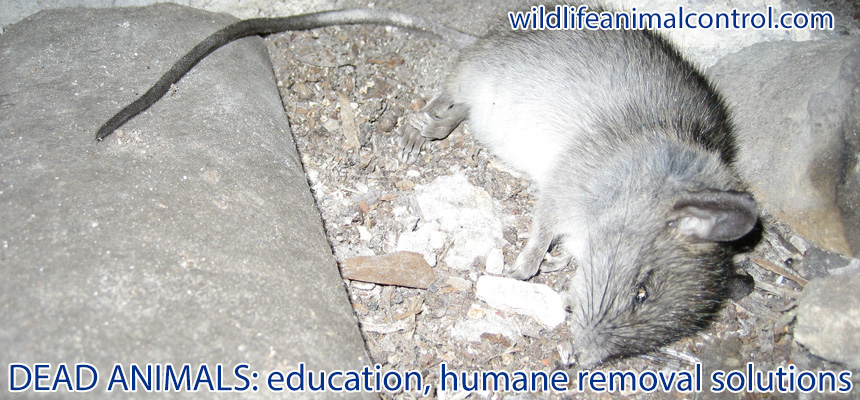
Dead Animal Location: In a closer indoor setting, a dead animal is often noticed by the increase and decrease of odor. In a home, the air flow will indicate where in the structure a dead animal is. If the smell is strongest in the heat of the day, the animal probably isn’t located in the basement. Similarly, knowing where an animal will go when it is about to die can help you locate the body. Many animals, depending on the reason for death, will feel the need to seek out water prior to expiring. Sick animals will often head to their nests or dens for comfort. When their body temperature begins to drop, they will seek out a heat source.
Click here to read more about how to find a small dead rodent in a house or walls, since small animals like rats and mice are usually harder to locate, even though the odor they give off can make the whole house smell terrible.
A dead animal outside can be located in a number of ways. If the animal was recently injured and you are attempting to track it down, there are a few tricks that can be employed to make the task easier. First, look for a blood trail. Keep in mind that as long as the animal is moving the blood will continue to pump through the body. Even a seriously injured animal can travel a significant distance if it is being pushed by adrenalin. If there is no blood trail, look at the landscape. An injured animal will move away from you in a hurry. Fear will negate the forethought of desired travel, making the route straight and unwavering. Stressed and hurt animals will also take the path of least resistance. When the animal feels it is not being pursued, it will lie down and die.
Animals that have been dead outside for longer than a day can usually be detected by the presence of carrion feeders in the immediate area. Vultures and other birds of prey will circle the general area of a carcass. Mass movements of predators into an area may also signify the presence of remains.
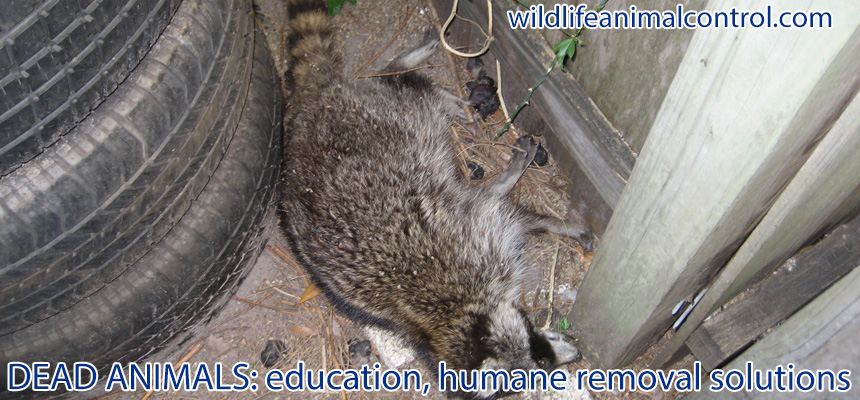
Hygiene Precautions: One of the most important things to do when dealing with any dead animals is to make sure that you take as many hygiene precautions as possible, which is a minimum of wearing rubber gloves. Some people will also want to wear a facial mask to cover the mouth, especially if the carcass is being moved. It is also wise to keep an alcohol gel close to hand in case any blood or fluid from the carcass finds its way onto your skin, and at least one or two tissues for the same reason.
Another important thing to do is to shower immediately after moving or handling the dead animal, and also to wash the clothes you are wearing immediately. There are many wild and domestic animals that will carry parasites, and once the host dies these parasites will look to attach to the nearest compatible host, which will often be you if you are handling the carcass. Washing the clothes will also minimize the risk of these parasites from infesting your home, which they can do if the clothes are left in the basket for a few days.
Click here to read more about how eliminate the dead animal smell in the house with various types of cleaners. However, remember that the most important thing is finding and removing the carcass.
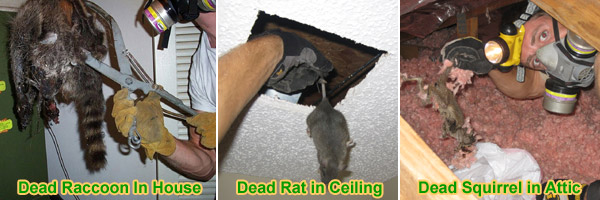
What To Do With The Carcass: The first thing to do is to check and see if there are any state regulations about disposing of an animal carcass. Some will insist that wild animals will need to be incinerated at a state facility. If there are no regulations governing the disposal of animal carcasses, the majority of small animals should be double bagged in a thick plastic bin liner, and then placed in the garbage. For larger animals, it may be difficult to deal with the animal yourself, so moving it away from the road or away from a public pavement until a state official can collect the carcass will be the best option.
Dead Animal Concerns: The most offensive part of a dead animal is the smell, though a host of other issues can occur. Dead animals may draw in other, larger predators to feed on the carcass. If in a home, a dead animal can facilitate the reproduction of flies, resulting in an infestation of the insects. Damage to homes can also happen if the bodily fluids from the decomposing tissue seep into walls, floors, ceilings, or duct work. Cleaning and repair can be costly and time consuming.
Dead Animal Diseases: The most common illness from decomposing bodies has to do with water contamination. When intestinal fluid leeches into a water system, it can cause severe upset in those that drink the contaminated water. Aside from that, the nausea and headaches from overwhelming odors are all legitimate concerns, though are not from direct contact with decomposing material. Secondary illnesses, such as contamination spread through the fly population, can be a concern. Any suspected dead animals should be removed from the immediate location. Animals left outside will be a food source for other animals, but those new pests may pose greater risks than the original, deceased creature.
Dead Animal Appearance: The definition of a dead animal is an animal that has forever ceased the functions necessary for the continuation of life. Brain activity has stopped. There is no breathing; no heartbeat. All metabolic functions have stopped. This death can occur naturally or by deliberate infliction. A dead animal will have no eye reflexes. The body will quickly lose warmth. Any color in the mucous membranes will ebb away and be replaced by paleness. This is because the blood has pooled in the lowest point of the body. Eventually, the limbs will become stiff and unmovable.
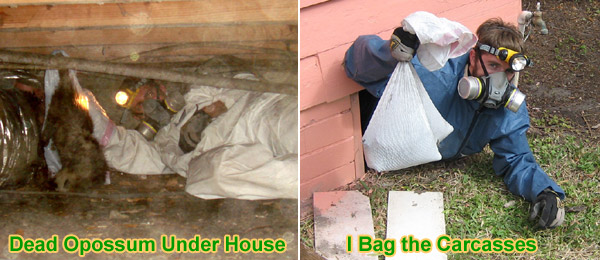
This site is intended to provide dead animal education and information, so that you can make an informed decision
if you need to deal with a dead animal problem. This site provides many dead animal control articles and strategies, if
you wish to attempt to solve the problem yourself. If you are unable to do so, which is likely with many
cases of dead animal removal, please go to the home page and click the USA map, where I have wildlife removal experts
listed in over 500 cites and towns, who can properly help you with your nuisance dead animal.

















